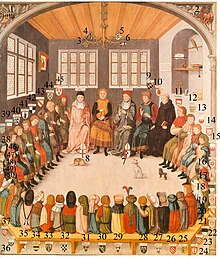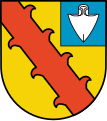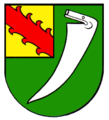Gundelfingen (noble family)
The von Gundelfingen family was a noble house , which in the 11th century divided into the branches of the lords of Gundelfingen, Steusslingen and Justingen . It was a family with an important political position, extensive possessions and belonged to the great Swabian noble houses. Individual family members were high church dignitaries.
origin

The eponymous place name Gundelfingen is Gundelfingen in Lautertal for this gender . Hohengundelfingen, Niedergundelfingen and Wittstaig together form the Gundelfingen district of the city of Münsingen .
Swigger von Gundelfingen was the first known representative of the sex. He appeared on February 26, 1105 as a witness at a donation of goods to the monastery of St. Blasien . Swigger and his wife Ita von Entringen had eight sons and several daughters, three of whom were sons and several daughters who entered the clergy. Swigger was a supporter of King Heinrich IV. He was banished from his old home Bavaria after the killing of a relative and was able to build a new home in the Lautertal through connections (to Archbishop Anno of Cologne?) And money.
Family development

The armed conflicts between King Rudolf von Habsburg and Count Eberhard von Württemberg and part of the Swabian nobility, as well as the throne struggles of Adolf von Nassau , severely affected the Gundelfingen family. In the core area of the House of Gundelfingen, the division after 1250 resulted in three smaller dominions and lines:
- the town of Hayingen with Otterswang in Upper Swabia , which fell to the eldest son.
- the family castle Hohengundelfingen with accessories as part of the second son Swigger and the
- Lordship of Niedergundelfingen, with Nieder- or Neugundelfingen Castle built around 1250 .
The sale of the Hohengundelfingen ancestral castle with countless goods and rights to the House of Habsburg in 1293 and 1306 should be seen in this context . The fact that the castle subsequently remained in the hands of the Gundelfinger as a pledge or fief until 1377 indicates a political connection with Austria . Gundelfinger were also supporters of Emperor Ludwig of Bavaria, and one branch came to high and influential offices in Bavaria until the 15th century.
The house achieved important positions and a high reputation in the 15th century, primarily through members of the Niedergundelfingen line founded around 1250. In addition to his brother Konrad, who retained the castle built around 1250, Degenhard Münzdorf received the remaining property and built Derneck Castle in the first half of the 14th century. Ehestetten received another line branching off from Niedergundelfingen and built Ehrenfels Castle above Zwiefalten. Degenhart became the progenitor of the last surviving branch. His grandson, Stephan von Gundelfingen-Derneck, bought the village and castle Neufra on the Danube in 1399 . Under his descendants, Neufra became the seat of the family in the 15th century. In 1414 he succeeded in taking Hohengundelfingen into his possession as a pledge. His sons Wilhelm and Degenhart bought Hayingen back in 1442.
The members of the House of Hohengundelfingen held high state offices in Württemberg for four generations in the 15th century. The last representative was Schweikhart von Gundelfingen. He was the councilor of Duke Ulrichs von Württemberg . 1513–1517 he was Obervogt in Urach and after the expulsion of the Duke, Austrian governor in Stuttgart. During the Peasants' War , as the Austrian commissioner, he was involved in negotiations with the rebellious peasants on several occasions. After the end of the war he campaigned for a fair compensation and leniency towards the defeated peasants. Until his death in 1546 he was the councilor of King Ferdinand. He bequeathed the rule of Gundelfingen to the Counts of Helfenstein , after whose extinction it came to the Fürstenberg family in 1627 (Messkirch line, Stühlingen line in 1744).
Other Distribution: Castle in Burgweiler , castle ruins Neugutenstein , castle Bichishausen , Burg Granheim , ruin Otterswang , castle Buttenhausen , ruin Alt Ehrenfels
Related sexes: Zimmer
Personalities
- Konrad von Gundelfingen : (1284–1302) as Konrad III. von Gundelfingen Prince Abbot of the Prince Abbey of Kempten and (1288–1291) counterabot of the Prince Abbey of St. Gallen
- Andreas von Gundelfingen : Bishop of Würzburg (1303-1313)
- Heinrich von Gundelfingen: Abbot of the Prince Abbey of St. Gallen (1411-1418), see also: Battle of the Letzi
- Heinrich von Gundelfingen: historian († 1490), first records about Niklaus von Flüe
- Barbara von Gundelfingen : (1473–1523), abbess of the free worldly women's monastery in Buchau
coat of arms
The coat of arms of those of Gundelfingen shows a red sloping bar with a thorn cut on a golden background.
Various communities and districts still remember the gender in their coat of arms.
literature
- Alfons Uhrle: Regesten on the history of the nobles of Gundelfingen, Justingen, Steusslingen and Wildenstein . Tubingen 1960.
- Heinz Bühler: The noble lords of Gundelfingen-Hellenstein - A contribution to the history of the East Swabian nobility in the high Middle Ages , in: Yearbook of the Historisches Verein Dillingen 73 (1971), pp. 13-40.
- Alfons Uhrle: Contributions to the history of the Lords of Gundelfingen , in: Münsingen, history, landscape, culture. Commemorative publication for the anniversary of the Württemberg State Unification Treaty of 1481 , edit. by Rudolf Bütterlin and Viktor Götz, Sigmaringen 1982, pp. 175–195.
- Gunter Haug : The first crusader - the adventurous life of the swigger from Gundelfingen . 2005. ISBN 3-87181-013-4 .
- Gunter Haug: The gentlemen from Gundelfingen . Baader Publishing House Münsingen 1996.
- Karl H. Lampe: Gundelfingen, from. In: New German Biography (NDB). Volume 7, Duncker & Humblot, Berlin 1966, ISBN 3-428-00188-5 , p. 314 ( digitized version ).
See also
Web links
- History of the castles in Lautertal on the homepage of the city of Münsingen
- Christof Paulus: Gundelfingen-Hellenstein, noble family . In: Historical Lexicon of Bavaria
Individual evidence
- ^ In Gundelfingen on the Danube , Billung von Gundelfingen appears in 1096 as a member of a noble family. In: City history of Gundelfingen an der Donau ( Memento of the original from May 12, 2008 in the Internet Archive ) Info: The archive link was inserted automatically and has not yet been checked. Please check the original and archive link according to the instructions and then remove this notice. - It can be assumed that there are other families with the same name (see also: Gundelfingen ).






